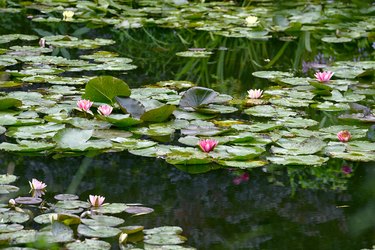
Pond habitats do not stop at the water's edge but continue on for several yards. Animals that live around the pond do so because it is their prime source for water and food. All the plants and animals in a pond form the ecosystem that nurtures and maintains the water and surrounding habitat. Since all the elements depend on each other, once one crucial organism is removed, chances are the ecosystem of the pond will slowly deteriorate over time.
Plants in a Pond Ecosystem
Video of the Day
Successful ponds have lots of different plants growing in them. These plants provide food, oxygen and even shelter for animals living in and around the pond.
Video of the Day
Plants need sunlight for photosynthesis, so sunny ponds are more successful than those situated in shady areas. There is a food chain in the pond, and it starts with microscopic phytoplankton and algae. These are eaten by fish and small animals, which are then eaten, in turn, by larger animals.
Bank Side and Marsh Zones
There are different zones around a pond. The area farthest away from the pond but is still damp is called the bank side. In a manmade pond, this is a buffer zone between the pond and a farmed or landscaped property. Plants that enjoy dampness thrive in this zone. Such plants include willow herb and meadowsweet.
The marsh zone is at the water's edge, and plants that grow in this area attract such animals as frogs to the pond. Yellow flag iris and sedges are marsh plants. The tall stems of sedges are good hiding spots for young amphibians and dragonfly nymphs.
The Aquatic Zone and Plants
True aquatic plants such as Canadian pondweed and waterlilies live in this zone. Waterlilies have roots that are buried in the mud of the pond bed, but the leaves and flowers float on the surface. Other plants such as duckweed are surface floaters. Their roots dangle down into the water. Floating plants should not cover the entire surface of the pond because the submerged plants will be unable to live.
Fully submerged plants that live in ponds, such as starwort and pondweed, provide oxygen to the pond so they are essential to the health of fish. And the more fish a pond has, the healthier the pond is.
Animals in a Pond Habitat
While fish are the most common life form in a pond, there is a multitude of animal species that live in and around ponds. Among the common pond animals are snails, turtles, snakes, newts and salamanders.
Frogs and toads also flock to ponds to lay their eggs and dine on mosquitoes and their larvae as well as on dragonflies and water spiders. Birds that dive for fish or eat pond plants and insects include ducks, geese, kingfishers, herons as well as gulls, red-winged blackbirds and swallows.
Small mammals like water voles and shrews also call a pond their home. Voles are primarily vegetarians and eat bulbs, roots, seeds and other plant matter. Shrews do eat seeds, but feed mainly on earthworms, slugs and insects.
Pollution and Pond Life
Bacteria abound in a healthy pond environment. Waste from the living and dead animals that reside in the area is broken down by these bacteria and recycled. There is no pollution in a healthy pond.
Pollution occurs when people intrude on a pond habitat. One form of pollution is dumping of garbage and trash. Other forms include pollution from chemicals such as pesticides that run off farms or lawns and seep into the groundwater.
Too much fertilizer can also cause problems when it seeps into ponds. It encourages algae overgrowth. Too much algae exhausts the oxygen in the pond, both while the tiny plants are alive and when they decompose after dying. The resulting lack of oxygen can kill off pond life.